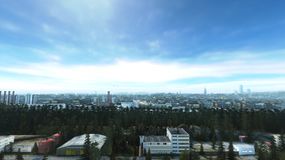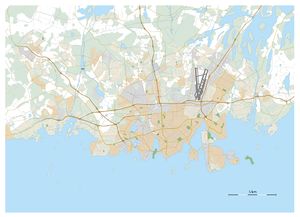Stalburg
| Capital City of TSL country | |
|---|---|
|
| |
|
| |
The City of Stalburg (SB) is a capital of fictional Scandinavian country of TSL and a Region of Stalburg, that is located on Baltic sea with Hanseatic and Novgorodian origins. City has nearly two million citizens living within it.[1]
History
Early middle ages (before 1200)
There were small unnamed fishing village in the area of current ‘Fishermen bay’
Late middle ages (1200–1400)
Hanseatic league and Novgorodian traders founded Stalburg as iron mining settlement, in the area of currently known ‘Old town’. They also constructed small castle to protect the new founded settlement of Stalburg Between 1200’s and 1400’s the settlement grew and granted full city rights. Castle was also expanded.
Renaissance (1400–1600)
During 1400’s the original settlement suffered great damage during the Stalburg Fire. After the fire the city was decided to be relocated to the current site of the city center at a bay 5km east of the original location due it’s obscure location for port and rough cliffy terrain. The old castle was abandoned and new fort were built to cover the location of the new Stalburg.
Neoclassicism (1600–1800)
The city started to grow fast and it became wealthy and important harbor and trading city in the Baltic region. Many new sea forts were built to protect the important port. INFRA: Game Design Document
Industrialization (1800–1900)
The city’s status as important port and iron mines allowed the city to industrialize fast, boosting the city’s growth and economy even more. Many factories were constructed in districts around the times city limits and coast, such as ‘Foundry’. Railroads were also constructed. On the other side of the coin, the fast industrialization caused many people seeking jobs to migrate into the city, faster than new apartments and tenements we’re built, forming slums around the city. During that time the city also suffered some sanitation, pollution and health issues. At the late 1800’s work started on improving the sanitation and water quality. Sewers and water pipes were built under the city and some of them are still operational.
Modern times (1900-1938)
During the early 1900’s the slums surrounding Stalburg we’re removed and replaced with proper housing.
Stalburg in WW2 (1938-1945)
During WW2 Stalburg suffered a lot of damage from German bombings.
Modern times (1945-)
After the events of WW2, the city contracted the Bergmann Group to construct many of Stalburg's underground infrastructure. Bergmann got lots of help from a local company called Stalburg Steel, who supplied them with steel to aid in the construction of the vast underground tunnel networks. Another company that benefited from Bergmann was Hammer Valley Hydro, who relied on Bergmann's water tunnels to keep their two dams, Hammer Valley Dam and Two Gorges Dam, operational. During the early 1980s, things started to go wrong in Stalburg. It started with the Bergmann Group going bankrupt due to the disappearance of Xeander Berg, who had plans for an invention that would change the world of construction forever, textile-reinforced concrete. Eric Kleinmann was forced to sell his company to Jeff Walter. Next was Stalburg Steel. Bergmann used Stalburg Steel to get steel for their construction projects. After the bankruptcy of Bergmann, Stalburg Steel didn't have anyone to sell their steel to anymore. Mikhail Rosenthal had to sell his company to Jeff Walter. And finally, Hammer Valley Hydro. After the Bergmann Group was gone, no one could maintain the tunnels that Hammer Valley Hydro relied on to get logs through. The CEO of Hammer Valley Hydro, Alex Hartman, after being forced to sell his company to Jeff Walter, got really mad at what Jeff was doing, and since then, he was searching for Walter to seek vengeance. Alex found Jeff at Rosenthal's villa in 1986, where he murdered him in cold blood. From then on, Stalburg was never the same. Many former workers of these companies ended up in Obenseuer, a crumbling part of Stalburg to which homeless people are taken. Currently, much of Stalburg's infrastructure is in atrocious state, and the city is on the brink of collapsing due to the un-maintained underground tunnels. This is of course until Markku Siltanen who documents the true state of Stalburg's infrastructure, which causes a massive investigation into the corruption of many politicians. One year after Mark successfully shut down the reactor [Depending on ending], which was at risk of exploding due to the collapse of the Two Gorges Dam, the city looks to be recovering, with NCG put in charge of maintaining most of Stalburg's infrastructure.
Transportation
Rail Transport
From Stalburg Central Railway Station there are 10 regional lines that connect other cities and towns in Stalburg Region: R10 to Forde, R11 to Forde, R12 to Illo, R130 to Ardscratch, R15 to Tilstrand, R20 to Ersfors, R21 to Koksburg, R230 to Cellecter, R30 to Sydhavn, R330 to Ploughwedge.
The city of Stalburg has 4 line citywide metro system operated by Stalburg Mass Transit. The player will use and visit parts of the metro system during his journey. The metro system is also a way for the player to perceive the scale of the city and his movement relative to it.
Road Transport
City is connected by five motorways: M1 (west), M2 (north-west), M3 (north), M4 (north-east) and M5 (east)[2]. Presumably the M3 was used by Mark on his way to Hammer Hydro Valley, while part of M2 was used after the city blackout when Mark had to get to Blackrock Nuclear Power Plant.
Air Transport
City has one airport named Stalburg Internation Airport (SIA).
References
- ↑ https://imgur.com/gallery/7xSBG
- ↑ Oskutin: 1, 2, 3, 4, 5 from west to east.

